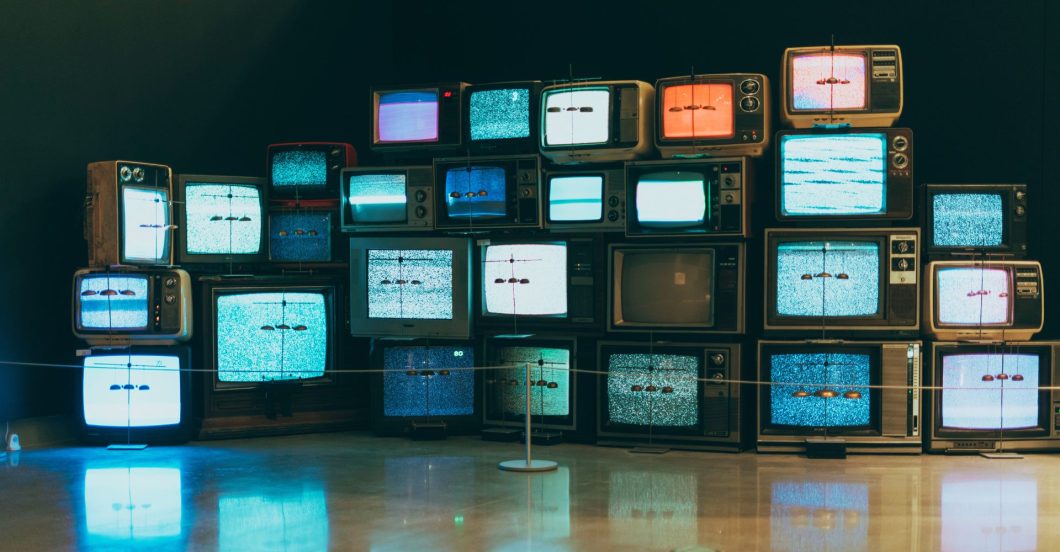We bought a television, Gabe and I, a few days ago. It’s the first TV we’ve owned as a couple, a shocking and disturbing development. When we moved in together six months ago, it was under the assumption that we would never buy one. We considered ourselves above the people who spent an entire Sunday binging Netflix on their 70-inch plasma screens. Not that we didn’t spend entire Sundays binging the same shows, but we did so with a degree of ascetic restraint, on a laptop—that relic of the days when we’d just met and invited one another over for movies. Of course, the movie was just a formality. In those early days together, I couldn’t name a single movie we watched, nor what happened in any of them.
As our relationship became more domestic, the laptop presented more trouble than passion. Gabe would lean against one corner of the couch. I would either rest against him or occupy the other corner, squinting at the coffee table as if peering into a microwave. The paltry screen size required one of us to ask every few minutes what was happening—is that a gun he’s flinging around? a phone? a burrito? And because the sound came only from the tiny laptop speakers, muffled by dust and cookie crumbs, we would often replay the same scene numerous times, straining to decipher what the characters said. Even a seasoned Star Wars fan, listening from our couch, would swear the Jedi catchphrase is “May we forcibly eat you?”
By January, the situation became untenable. A day of wet snow would melt by the afternoon and freeze overnight to sheets of ice, making any venture outdoors a likely opportunity for tearing knee ligaments and cracking skulls. We stayed cooped up in our one-bedroom, drinking coffee and shopping for things we couldn’t afford. Seasonal depression had set in, a thoroughly suffocating weighted blanket we couldn’t get out from under.
“I’m languishing,” Gabe would say, splayed on the couch with his hand over his forehead like a Victorian duchess.
“Same here,” I would say.
It became a script we recited—our own sad, single-scene kind of movie.
On yet another stormy Friday, we found ourselves shut in at 7 p.m. while the roads turned to skeleton tracks. Gabe hunched over the laptop scrolling for something worth watching. I craned my neck trying to see over his shoulder. With a sigh he fell back into the couch cushion.
“I can’t live like this anymore,” he said.
I knew what he meant, but I was scared. The average American spends five hours a day watching television. I get it. Watching TV is one of those things you can get lost in, lose track of time, that similar flow state long-distance runners and musicians talk about, except instead of transcending to a spiritual realm, you’re checking in to see who Kim will marry next on Keeping up with the Kardashians. I worried that getting a TV would be a sort of gateway drug, a downward spiral that would end with a home theater in the bathroom.
But I knew Gabe was right. We needed an upgrade.
First we tried a projector. The logic was that the projector could be easily dismantled and hidden when we weren’t watching something. In this way, we could continue to keep up the appearance that we were not “Television People.” The projector also cost about half of what we’d pay for a TV of the same screen size. It seemed like the perfect compromise.
But after we turned on the projector, connected it to the laptop and nestled in to watch, we realized the projector’s primary weakness. It takes a certain amount of time for the content on the laptop to transmit to the projector screen. It’s an ever so slight amount of time, mere milliseconds, but it’s disastrously obvious when characters’ mouths are moving to a different tempo than the words they’re saying. It’s like watching a band perform whose drummer is two beats behind.
Resigned, we went where all Americans go to find the answers to our material needs: a Walmart SuperCenter. It had been more than a year since I’d last been inside one, and the initial entrance—automatic doors opening into the aisled vastness, the crisp glare of warehouse-grade LEDs—was like stepping into sunlight after living inside a cave.
We walked to where the televisions boasted whatever high-tech features justified their price tags. I admit that the ones costing upwards of $1,000 really did seem worth every penny. One showed a street video of Venice at night. The display was so large that I felt not only immersed in the scene but engulfed by it, swept up in the depth of the colors, the vibrancy, a sensation not unlike hallucinatory mushrooms. Thinking of the television as one very expensive hallucinatory mushroom that could be indulged with the click of a button made its cost more sensical. People shelled out gobs of money on this thing for the experience, an experience I now understood.
Our budget lay on the opposite end of the row, toward the humbler spectrum of the three-figure range. Even these were impressive. All of them offered 4K resolution, whatever that meant. For $70 more, you could get an “assistant-compatible” TV that let you turn the thing on by saying a simple command from, say, the back patio or the toilet. Since we don’t have a back patio, we opted for the 50-inch with crystal processor and crystal display because, as Marilyn Monroe once said, “Diamonds are a girl’s best friend.”
For $400 plus tax, this behemoth was ours. A squadron of blue-vested employees hoisted it into the back of my truck.
“Wow, you got the Samsung,” one of them said. “I’m jealous.”
I smiled and shrugged, trying to act modest. But driving away, I felt it, that delicious sensation of owning something others covet. I put my hand on Gabe’s leg.
“This is a big step for us,” I said.
I meant it as a joke, but was it?
We are TV people now, and that means something—exactly what, I’m not sure, but whoever we’ve become feels like an improvement of who we used to be. To those who aren’t TV people, those who think this makes you honorable or righteous, don’t worry, I was like that too, once. One day you’ll come around.
Photo by Nabil Saleh on Unsplash
